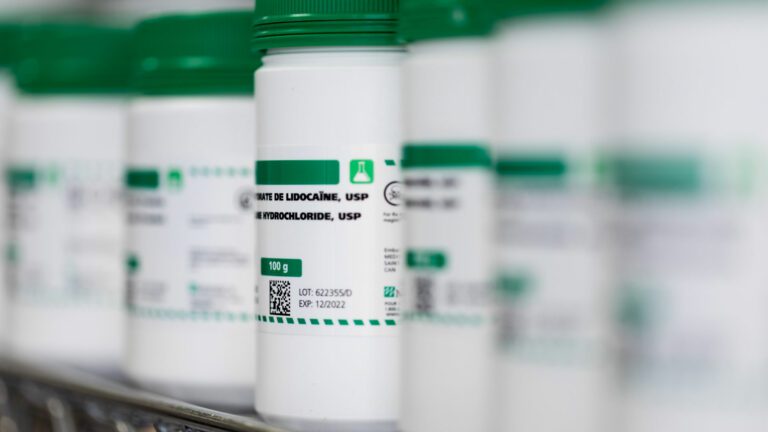
The compounding of drugs is an integral part of pharmacist and pharmacy technician practices. That’s why it is crucial that pharmacy teams comply with the Standards for the Compounding of Non-sterile PreparationsSterile compounding and the Standards for Compounding Non-hazardous and Hazardous Sterile Preparations.
To understand and apply the standards, it’s important to know what compounding is, and what it is not. Health Canada provides the following definition:
“The combining or mixing together of two or more ingredients (of which at least one is a drug or pharmacologically active component) to create a final product in an appropriate form for dosing. It can involve raw materials or the alteration of the form and strength of commercially available products. It can include reformulation to allow for a novel drug delivery. Compounding does not include mixing, reconstituting, or any other manipulation that is performed in accordance with the directions for use on an approved drug’s labelling material.”[1]
In addition, ACP’s sterile compounding standards require sterility for the reconstitution and certain manipulations (according to manufacturers’ instructions), and for the repackaging of approved sterile products, regardless of the route of administration. These activities are considered to be sterile compounding.
“Compounded sterile preparations include the following:
- nasal inhalation solutions;
- respiratory therapy solutions;
- solutions for live organ and tissue or graft baths;
- injections (e.g., intramuscular, intravenous, intrathecal, intradermal, subcutaneous);
- irrigation solutions for wounds and body cavities (e.g., thoracic, spinal, abdominal, pelvic);
- ophthalmic drops and ointments;
- otic drops for intratympanic administration;
- parenteral nutrition;
- dialysis solutions;
- allergen extracts;
- topical preparations (where sterility is essential to the therapy, e.g., for patients with burns); and
- radiopharmaceuticals.”[2]
Here are some factors Health Canada recommends considering when assessing whether an activity is compounding:
- “Healthcare professionals who provide compounding related services and products to patients/clients must be able to demonstrate that a patient-healthcare professional relationship exists.
- Activity is regulated and facility may be inspected by provincial/territorial regulatory authorities (e.g., ACP).
- It is expected that healthcare professionals who compound products will have appropriate risk management processes in place to manage risks associated with the compounded product and the workplace (facilities, safety etc.), in line with the standards set by their provincial/territorial regulatory bodies (for example but not limited to the toxicology, pharmacology, therapeutic value, stability, adverse reactions, labelling requirements etc. of the compounded product).
- A pharmacy may prepare drugs in very limited quantities, in anticipation of a prescription. For the purpose of this Policy, preparation involves compounding or repackaging of multiple units, not for immediate use, in a single process, by the same operator in accordance with a standardized batch preparation procedure.
- Compounding should only be done if there is a therapeutic need or lack of product availability and should not be done solely for economic reasons for the healthcare professionals.
- The compounded product must provide a customized therapeutic solution to improve patient care without duplicating an approved drug product.
- When there is a shortage or no supply of a commercially available product and the healthcare professional has determined a medical need for this product, the product may be compounded during the period of shortage or no supply only.
- Drugs should not be compounded in order to be sold to third parties who will in turn sell/deliver to patients outside of their defined patient-healthcare professional relationship.* Pharmacists that do not provide specific compounding services may contract this activity to another pharmacist who provides this type of specific compounding service.”[3]
*This includes pharmacies selling compounded preparations to a second pharmacy which then sells to a third pharmacy.
All pharmacies in Alberta must comply with ACP’s non-sterile and sterile compounding standards. They should already be compliant with priority one (assessing risks and gaps) and priority two (compounding and cleaning, personnel training, and quality assurance). Pharmacies must comply with priority three (facilities and equipment) by July 1, 2021. That means all necessary equipment must be in place and all renovations needed to comply with the standards must be completed by that date. All new pharmacies, and those relocating or renovating, must comply with all three priorities now.
For more information about the standards, including guidance, the “getting started” document, compounding essentials, FAQs, and templates, visit the non-sterile compounding page and sterile compounding page of the ACP website.
[1] https://www.canada.ca/en/health-canada/services/drugs-health-products/compliance-enforcement/good-manufacturing-practices/guidance-documents/policy-manufacturing-compounding-drug-products.html. Accessed November 23, 2020.




